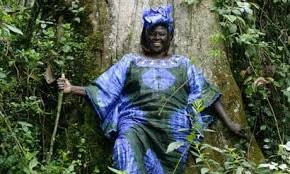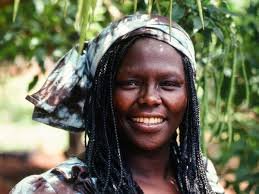Roots of Resistance: Wangari Maathai Childhood in Colonial Kenya
Born on April 1, 1940, in Nyeri, Kenya, Wangari Maathai grew up in a world of contradictions—the fertile green hills of her Kikuyu homeland were shadowed by British colonial rule. Her family, like many, had lost ancestral lands to white settlers, a trauma that would later fuel her environmental activism. Few know that young Wangari’s first act of defiance came at age 8, when she uprooted invasive eucalyptus saplings planted by colonial officers, replacing them with native fig trees. This early connection to the land was nurtured by her mother, who taught her that every felled tree diminished their community’s future.
Her academic brilliance earned her a rare opportunity—the “Kennedy Airlift” scholarship to study in America in 1960, where she witnessed the civil rights movement firsthand. At Mount St. Scholastica College (now Benedictine College), she majored in biology, but it was a sociology lecture on Rachel Carson’s Silent Spring that ignited her passion for environmental justice.
Breaking Barriers: Wangari Maathai From Scientist to Kenya’s First Female PhD
Returning to Kenya in 1966, Maathai shattered glass ceilings at the University of Nairobi, becoming the first East African woman to earn a PhD (in veterinary anatomy) in 1971. Her doctoral research on bovine reproduction was groundbreaking, but her insistence on publishing under her own surname (rather than her husband’s) caused a scandal. This personal rebellion foreshadowed her later battles—when her husband divorced her in 1979, publicly declaring her “too educated and too strong-willed,” the judge agreed, stripping her of her home.
Undeterred, she channeled her energy into the National Council of Women of Kenya, where she made a startling discovery: rural women’s struggles for firewood and clean water were directly tied to deforestation. This insight birthed her life’s work.
The Green Belt Movement: Planting Trees, Planting Hope of Wangari Maathai
In 1977, Maathai founded the Green Belt Movement (GBM), which began as a few women planting seven trees in a Nairobi park. The idea was radical in its simplicity: pay women a small stipend to grow native seedlings, reversing deforestation while empowering communities. By 2004, GBM had planted over 30 million trees and trained 30,000 women in sustainable forestry.
One lesser-known tactic was her “tree funeral” protests—when developers razed forests, Maathai led mourners in traditional Kikuyu burial rites for the fallen trees, complete with coffins made of twigs. These theatrical demonstrations drew global attention to Kenya’s ecological crisis.
“The Trouble Maker”: Battling the Moi Dictatorship
President Daniel arap Moi’s regime saw Maathai as a dangerous agitator. In 1989, she led protests against the $200 million Times Tower project, which would have destroyed Nairobi’s Uhuru Park. Moi called her “a madwoman” and “a threat to national security.” Government thugs beat her unconscious during one demonstration, but she returned days later with more supporters.
Her boldest stand came in 1992, when she staged a hunger strike with mothers of political prisoners at Nairobi’s Freedom Corner. After 11 days of police brutality—including tear gas attacks that hospitalized her—the government released 51 detainees. This victory proved nonviolent resistance could work, even under dictatorship.

Wangari Maathai Nobel Glory and Global Influence
When Maathai won the 2004 Nobel Peace Prize (the first African woman to do so), the Norwegian Committee praised her for “linking democracy, human rights, and environmental sustainability.” Behind the scenes, the award almost didn’t happen—Kenyan officials had secretly lobbied against her nomination, fearing her international platform.
Her Nobel lecture included a stunning revelation: she tied Kenya’s deforestation to British colonial policies that replaced food crops with cash crops like tea, creating cycles of poverty and environmental degradation. This critique of neocolonialism resonated across the Global South.
Parliament and the Fight Against Corruption
Elected to Kenya’s parliament in 2002, Maathai used her position to expose “land grabs” by political elites. Her 2005 investigation revealed that a forest reserve had been illegally sold to developers—including a hotel owned by Moi’s family. Death threats followed, but she persisted, wearing a necklace of seeds as a silent protest during parliamentary debates.
Her most controversial move was opposing a 2011 government plan to genetically modify Kenya’s staple crops, arguing it would make farmers dependent on foreign corporations. The bill passed, but her warnings foreshadowed today’s debates about food sovereignty.
The Cancer Battle and Secret Environmental Legacy
Diagnosed with ovarian cancer in 2010, Maathai turned her treatment into a research opportunity, documenting how environmental toxins might contribute to the disease. In her final months, she secretly drafted plans for the Wangari Maathai Institute for Peace and Environmental Studies, ensuring her ideas would outlive her.
She died on September 25, 2011, but not before planting one last tree—a fig sapling at her home, using soil mixed with ashes from her cremated beloved dog.
Seeds of Change: Her Living Legacy
Today, the Green Belt Movement operates in 30 countries, while Kenya’s constitution enshrines environmental rights—a direct result of her advocacy. Perhaps her most enduring lesson was that saving the earth isn’t about science alone; it’s about justice, culture, and remembering, as she often said, “We are called to assist the Earth to heal her wounds.”
Go to main page


